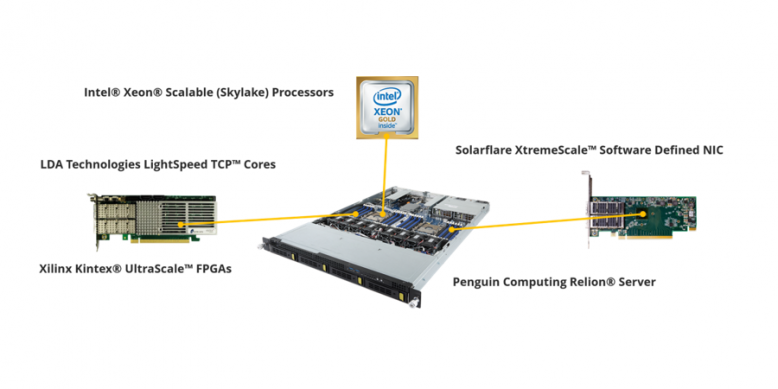STAC Report: STAC-T0 on Solarflare-enabled FPGA solution

Max Actionable Latency of 98 nanoseconds with 68-byte frames at 1 Gbps ingress
16 October 2017
Based on consultation with members of the STAC Benchmark Council, STAC has proposed a new benchmark suite called STAC-T0™ and has just used it to test a new solution from Solarflare Communications, LDA Technologies, and Penguin Computing. The STAC Report is available here.
STAC-T0 evaluates the tick-to-trade network-I/O latency of any trading platform extremely accurately, whether the platform involves CPUs and software, FPGAs, or other hardware. STAC-T0 treats the "stack under test" (SUT) as a black box, interacting with it solely via network packets, which it timestamps in hardware. The benchmarks measure the time between transmission of simulated UDP market data to the SUT and receipt of simulated TCP orders from it, without the SUT performing any trading logic or market-specific protocol handling. In this project, measurements had an uncertainty of just +/-2 nanoseconds, which is incorporated into the results.
The stack we tested consisted of a Solarflare SFN8522-ONLOAD adapter with LDA Technologies LightSpeed TCP firmware running on an Alpha Data ADMPCIE-KU3 FPGA, all hosted in a Penguin Computing Relion XE1112 Server. We tested at two message sizes and three message rates and reported four different latency measurements for each combination. The key measurement is "Actionable Latency", which is how long it takes the solution to start transmitting an order after all the algorithmically relevant portions of an inbound packet have been transmitted to the solution.
Of the many results, the partners above chose to highlight the following:
-
At 1Gbps, maximum Actionable Latency was just 98 nanoseconds for 68-byte frames and 109 nanoseconds for 507-byte frames.
-
At 1Gbps, maximum LIFO latency for 507-byte frames was -65 nanoseconds. (It was negative because the SUT was able to send simulated orders before the entire ingress packet was received.)
-
From the very low rate to the highest rate reported, across both message sizes, the maximum of each latency metric did not vary by more than 2 nanoseconds, which is within the measurement uncertainty of the test harness (+/- 2 ns).
In addition to the STAC Report, premium subscribers can access detailed analyses of each message size, message rate, and latency metric, a detailed STAC Configuration Disclosure, and a complete sosreport for the system, all at the link above. If your firm does not have access to these materials, please contact us or take a minute to learn about subscription options.
Note that we will discuss this project at the upcoming STAC Summits in Chicago, New York, and London.
About STAC News
Read the latest about research, events, and other important news from STAC.
